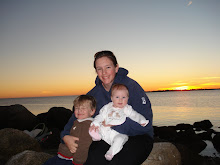When I taught 7th grade world geography, one of my favorite lessons of the year was during our introduction to stereotypes. The whole purpose of the lesson was to help students understand the value of being open-minded and appreciate how sometimes we all see the world a little differently, even if we're looking at the same thing.
I used to start each class with a photograph and have the kids write briefly about what they thought it could be and what questions they had about it. Usually, it was not something I expected them to know anything about, which was kind of the whole point. At the start of my this particular lesson, my picture of the day was an overhead view of some fishing nets in a muddy, African river. Seldom did anyone ever guess anything remotely close to what it really was, and I always loved hearing all of their different theories on what it could be: jewelry, an art design, an enlarged view of something microscopic. Then, we'd move on to looking at pictures like these, and I'd ask them what they saw. Usually they were split 50/50 on what they saw first. What do you see when you first look at this image? A duck, or a rabbit?
With this kind of illusion, of course, it's both. The tricky part is training yourself to be able to change your perspective so that you can see both images. My favorite thing about this lesson was that there were always kids who, no matter how hard they tried or strained their eyes, could not see the other half of the illusion. I loved watching students stand up and point out what they saw, trying desperately to get their peers to see the same. "It's a rabbit, see! It's kind of looking up. This is its nose, these are its ears..." Or, "It's a duck! This is its bill, and its eye and the back of its head... Don't you see??" Sooner or later, everyone was usually able to see both figures within the illusion, and it always made for a lively class. Then we'd look at a bunch of other famous illusions (some of which I'll include below) and repeat our conversations. Once we got around to discussing the main point of all this -- that other people's perspectives might be different than our own, but that doesn't make them wrong -- we were able to open the discussion up to times in our lives when we've felt misunderstood, wanted people to see things our way, or were convinced that we were right and someone else was wrong. It was a great little lead-in to future conversations about stereotypes that are so important to have, especially with middle schoolers.
But isn't this supposed to be a book review? You're probably wondering where on earth I'm going with this. If you've hung in here long enough and are still reading, I'll finally cut to the chase. Rosenthal's Duck! Rabbit! is a cute, clever take on the very conversations I always had in my classes described above. With each turn of the page, we hear the back and forth between the varying points of view. Is it a duck? Or a rabbit? It's definitely a rabbit. See, it's eating a carrot! No, see, it's a duck! It's quacking! I love the way the simple, bold illustrations help show young readers both points of view, and the ending has an adorable surprise, too. Is that an anteater, or a brachiosaurus?? My kids got a kick out of that one. We had fun looking for both animals in the pictures, and my son and both daughter said they were able to see the duck and the rabbit. It's simple and silly enough, but the message is a valuable one. When it comes to differing points of view, sometimes both people are right. It's taking the time to look at things from both perspectives that is important.
Do you see a young woman, Two faces, or a vase?
or an old woman?
Another cool illusion

















0 comments:
Post a Comment